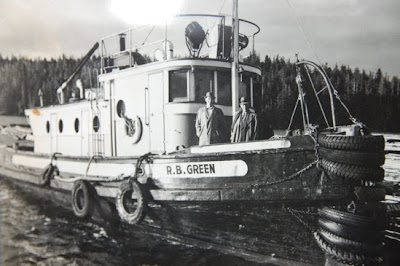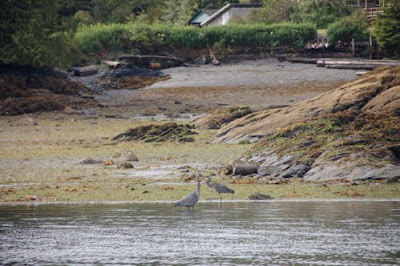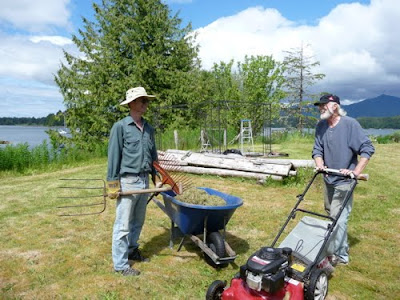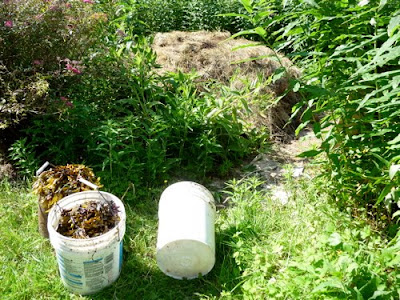Monday, September 20, 2010
TRACEABILITY
- was it grown in a way that is healthy for you and your family?
- was it grown in a way that is healthy for the planet ?
- did the farmer and/or workers receive a decent return?
- if an animal or marine product, was it raised/caught/killed with respect for the creature?
- is it unnecessarily processed? unnecessarily packaged?
- how much energy was consumed simply to get the food from where it was produced to your table?
They are important questions in this new world where sustainability is a must.
A recipe:
Put to soak a small handful of dried leeks (Thomas helped an older friend in Haida Gwaii this summer prepare her winter garden. He came back with an armload of leeks, onions and kale). Add the last of the dried mushrooms (Valdez Island, just across the narrows from our winter moorage on Gabriola).
Take one new potato, grown by a friend. Chop and sauté in a bit of sunflower oil. (We’re not sure about the sunflower oil. At least it says “Product of Canada,” and it’s not as likely to be genetically modified as in corn oil or canola.) Add the leeks and mushrooms, saving the soak water for soup stock.
Beat six eggs (a gift from Fran and Beau of Feel Good Farm, Porcher Island, across the Skeena mouth from Prince Rupert) and scramble with the potato, leeks and mushrooms. Add some grated cheese (made by somebody’s Swiss grandmother up in Telkwa).
Top with yogurt (homemade), black pepper (???) and alfalfa sprouts (grown on La Sonrisa, from Mumm’s Seeds, Saskatchewan). http://www.sprouting.com
Of course, we are much more fortunate than most people. But, you get the picture! Enjoy!
Saturday, September 11, 2010
CRIPPEN THEN AND NOW



on La Sonrisa was first on Grampa’s tug,
and then on the Earl Roy.
Grampa Green wrote a diary during the last 2 years of his life. Living with terminal cancer, he moved to the cabin at Crippen Cove on Digby Island. He writes of his daily activities. We were inspired to discover how much of what we do on this point of land in Metlakatla Pass is so similar to what Grampa did. Living simply, finding satisfaction in doing the work it takes to live. In many ways we are returning to the skills and activities Mckibbon sees as needed on planet “Eaarth”.
“I rowed down the shore for material to finish the Dry Dock, found what I needed” writes Grampa, on April 26, 1966. On that same day in ’67: I rowed down the shore for more scrap lumber to build fence, also tied up 3 small logs, that I think will do for the new float on the offshore mooring.
 Beachcombing with Chris Green, the widow of Grampa's son Bud.
Beachcombing with Chris Green, the widow of Grampa's son Bud.
She is the last family member of that generation left in Prince Rupert.
On February 16, ’66: A very wet day. I went beachcombing with the rowboat, brought back a load but not a very good quality. I cut some for firewood. I did some work on the floats.
Weather is a primary aspect of the simple life. It didn’t stop Grampa, just shifted what could be done. Firewood is a chore that is always on the list.
Jan 15: Spent the whole day splitting wood. Was all in at night. Went to bed at nine o’clock.
Grandson Thomas cutting firewood
Jan 17: I got another log in place for cutting on the high water. Afternoon I sharpened my old cross saw and cut some more drift wood with the swede saw, wheeled it to the wood shed and split it.

On the north coast the tides are dramatic, especially around the new and full moons. Everyone who lives in Crippen Cove lives by the tide. When you are in harmony with that rhythm, the tide can make many things possible.
April 2: I did some work in the garden and dug a hole for a post at the float to get ready for repairs. Also cut a float log to right length.
April 3: Phinney came back in time to help me raise the pole, which would have been hard to do alone. Worked til past 5 to get the pole set to do over the night tide.
Herons fishing at low tide, a long way out at a zero tide.
April 28: I have layed the boats out on the line for meeting the plane in the morning.
The clothesline is still the way Crippen folks position their boats for the tide. Great grandson Noel (with great, great granddaughter Daisy) built and maintains these rock stairs.
June 23: I put the mower in the raspberry patch and then clipped the edges and then mowed around the bushes at back of house and mowed the Badminton lawn. And made a start on the front lawn. I picked a dish of strawberries for dessert at supper.
at the cabin.
Here we are getting ready for a special event.
And building up the compost.
April 7: Another beautiful day. I started work to build a stairway up to the Front door.
Grampa worked for the next 2 days and finished the stairs on April 11.
Thomas and Ken building a new porch and stairs on the front of the cabin
March 28: A gale of SE with heavy rain all day. I put on oilskins and worked in the garden in forenoon, but stayed inside the rest of the day.
Wet weather gear
“Worked in the garden most of the day” is a repeated entry. Evidence of Grampa’s extensive garden is still all around the property, in rich soil, fruit trees, raspberries, gooseberries and currants, strawberries gone wild.

Feb 18: I got out early to get the tide and moved the big skiff to the beach and loaded it with seaweed. Afternoon I wheeled seaweed, made 18 trips but still quite a lot in skiff.

June 26: I picked the gooseberries and hulled them. There are 2 quarts.

April 22: I spent the whole day painting the bar tender. I put her on the grid at noon and when the tide left I scrubbed the bottom and wiped it off with rags, then painted the hull and bottom, finished at 5:40 and am all in. I will have to take her back to the float at midnight.
Feb 1: Partly rainy, spent part of day pruning currant bushes, and part making fishing gear.
April 3: I dug clams and crushed them for crab bait, hauled pot and had 2 nice crabs. April 5: I dug clams for more crab bait, then hauled crab pot. Had 2 crabs, gave them to Elmer Larsen.
Crabbing in the cove is sometimes very good!
McKibben’s vision for our times is “Think globally, act neighbourly.” Grampa’s Crippen neighbours are regularly mentioned in his diary, but they seem to give each other plenty of space. They share food, help out with work projects and sometimes keep each other company.
April 3: Gibson visited me and gave me 2 dozen eggs.
Gibson’s boat at Crippen – belongs to the son of Grampa’s neighbour
April 7: Ed Phinney came for supper. Fish & chips.
June 25: Phinney gave me a piece of meat for crab bait.
Jan 30: Visited Emil and had tea with him.
March 2: I went over to see Emil for a little while in the evening, and took the latest Geographic.
We had some wonderful connections with Crippen neighbours this summer.
Neighbours Chi & Matt & shared greenhouse produce
with us.
Sean next door started a market garden at his
childhood home
Beloved dog Crippen is a very friendly neighbour
The biggest cooperative effort this summer was Ken and Christianne’s wedding. Friends and neighbours joined in preparation and celebration.
Wedding vows on Crippen Point
And everyone put hearts together to make the whole day of heavy rain just a local colour aspect of an unforgettable day.
June 24, ‘67: This afternoon Bud and Chris came over. Bud finished mowing the lawn in front of the house. We cut a box of rhubarb for them to take home. My legs are very poor today.
Reg Green died in 1968 of the cancer he was living with as he wrote this diary.
Bud was Grampa’s son. His ashes are sprinkled in the bay around the bend. Grampa’s daughter Helen and her husband Ken, Thomas’ parents, had their ashes spread in Crippen Cove. This summer Thomas’ cousins came here to spread the ashes of their mother, Grampa’s daughter Joy Crane.
her life.
We continue to celebrate life at Crippen Cove with simple joys and sustaining work.


































